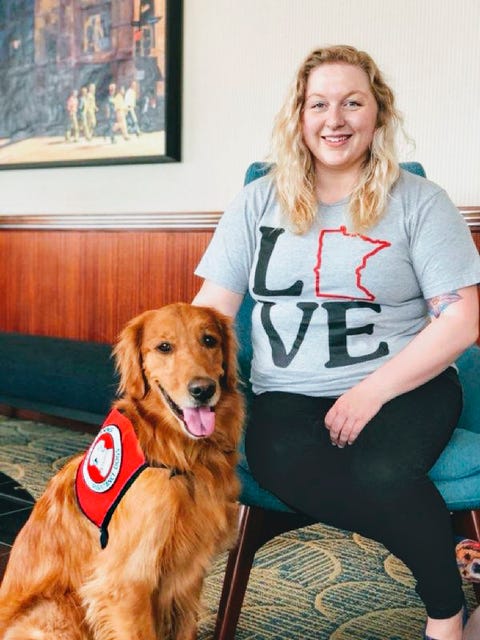Home » Health News »
‘My Service Animal Saved My Life’

Yep, you’ve heard the stories about emotional support peacocks on airplanes and probably rolled your eyes. But bonafide whip-smart assistance animals can actually turn women’s lives around.
So what’s the difference between a service animal and an emotional support animal? Only dogs, and in some cases miniature horses—yes, the world’s cutest heroes—legally qualify as service animals, meaning they’ve been trained to aid someone with a disability and are allowed in any public place.
Emotional support animals (companions for people with depression or anxiety) don’t have these rights, but often, with a doctor’s note, you can take them on a plane or in “no pets allowed” apartments.
These three women would be leading very different lives if not for their four-legged companions—their stories speak for themselves:
Madison Stangl, 28 and her diabetic-alert dog, Willy

Courtesy Madison Stangl
I was diagnosed with type 1 diabetes as a freshman in college. The disease, while life-changing, felt manageable at first. I kept an eye on my glucose with a monitor, and if I felt any of the warning signs of low blood sugar—such as sweating or dizziness—I’d use a pump to deliver the insulin my body wasn’t producing.
But three years after I was diagnosed, I developed hypoglycemia unawareness, a condition in which I no longer experience any of those medical red flags. I wanted to live alone, but I was terrified that I might fall into a coma in the middle of the night (a dangerous side effect of low blood sugar). So I was thrilled when a family member told me about dogs trained to sniff out a drop or spike in a person’s blood sugar through a unique scent in our breath or sweat that’s undetectable to humans.
I’m not sure I would have woken up at all that night if it weren’t for Willy.
In January 2017, Can Do Canines matched me with Willy, a 2-year- old golden retriever who’s now my 24/7 companion. Even before my glucose monitor detects a drop in blood sugar, Willy will paw at my leg or lie at my feet, so I know I need to grab juice or applesauce to bring the level back up. If I become debilitated from a drop, Willy knows to retrieve the glucose tablets I keep around the house, bring my phone over so I can call 911, and bark or scratch at doors to get help from neighbors.
Once, in the middle of a work meeting, Willy signaled that my blood sugar was dropping. I had tested myself recently and it had seemed fine, but I grabbed my meds just in case. It was good I did. Ten minutes later I had a scary crash.
Another night, while I was tossing and turning in my sleep, Willy roused me. My blood sugar was life-threateningly low. I’m not sure I would have woken up at all that night if it weren’t for Willy.
I used to be so afraid of my disease that I’d stay home, but with Willy around, I have a new sense of safety and confidence. I’m more social. And I’m finally getting my passport so I (and by I, I mean we) can start traveling.
Sam Okhuysen, 22 and her emotional support cat, Cleo

Courtesy Sam Okhuysen
My junior year in college, the depression, anxiety attacks, and obsessive compulsive disorder I had battled for years became so debilitating that I had thoughts of harming myself. I decided to apply for an emotional support animal (ESA). I went through a detailed application and interview process with my university’s disability office, and soon after being approved, I visited a shelter. There, I felt an immediate connection with Cleo, a 2-yearold tortoiseshell cat.
Cleo seems to have a sixth sense that helps her tune in to my emotions; if I’m angry, sad, or afraid, she rubs up against me until I pet her, which helps shift my mind away from what’s bugging me. Just knowing I have something to come home to and take care of helps me get through each day. I’ve received some flak from fellow students who think I only applied for an ESA so I could have a pet on campus, but most visitors light up when they see her in my dorm room.
Stacy L. Pearsall, 38, and her service dog, Charlie

Courtesy Stacy L. Pearsall
I was an air force photographer for 10 years before retiring in 2008 due to combat injuries—including trauma to my brain. Back home, I suffered from ongoing physical and emotional pain, PTSD, anxiety, and, later, seizures. I knew other veterans who had benefited from service dogs, but I didn’t want people staring or knowing that I needed help. Then, two years ago, I had a grand mal seizure, which changed my outlook. What if I had another one, this time without my husband around?
If I’m thrashing in my sleep from a PTSD nightmare, Charlie nudges me awake.
Last November, America’s VetDogs paired me with Charlie, now a 2-year-old black Lab, and I don’t leave the house without him. I have some deafness in one ear, and Charlie alerts me when people are coming up behind us, so I’m not startled—a leftover reflex from war. If I lose my balance, he presses up against me to stabilize me. If I’m thrashing in my sleep from a PTSD nightmare, he’ll nudge me awake or pull off the covers and put his head on my lap to be petted until my heart rate comes down. If I were to have a big seizure, he knows to find help if I’m alone and then lie by my side until I come around.
Charlie and I travel the country photographing veterans. His presence in public is a protection in and of itself. If I slur my words or fall, strangers might assume I’m intoxicated, but with Charlie by my side, they know I need help. I used to feel like a burden to loved ones, but now, I feel the shackles have been taken off.
This article originally appeared in the July/August 2018 issue of Women’s Health magazine. For more great advice, pick up a copy on newsstands now!
Source: Read Full Article
